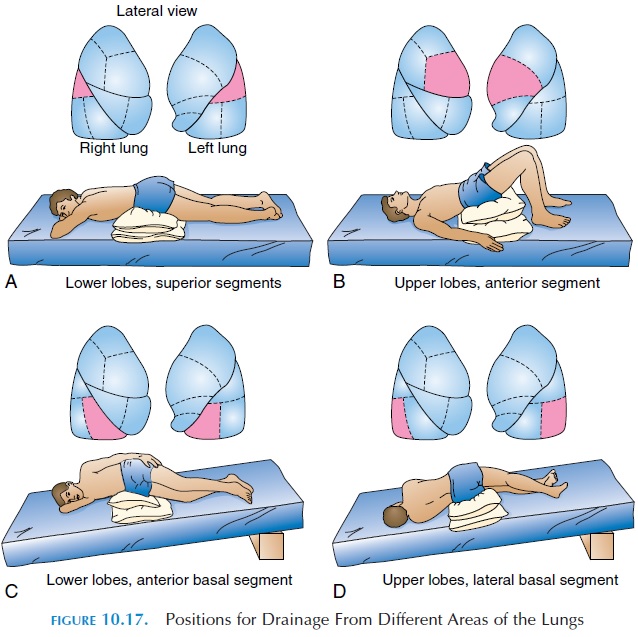Chapter: The Massage Connection ANATOMY AND PHYSIOLOGY : Respiratory System
Respiratory System and Massage
Respiratory System and Massage
Massage can have many positive effects on the respiratory system. A relaxation massage can slow the respi-ratory rate through its inhibitory effect on the sympathetic system. It can be beneficial to clients with breathing difficulty, especially if fatigued respiratory muscles are targeted. People with breathing difficulty often tend to alter their posture to reduce the effort of breathing. Massage, by relaxing these muscles, can have a profound effect on relieving the aches and pains originating from these muscles, and it has the potential to increase vital capacity and lung function by relaxing tight respiratory muscles and stretching fascia.
The client’s position may need to be altered ac-cording to the respiratory problem. Clients with breathing difficulty or requiring sinus drainage may be more comfortable in Fowler’s position in which the head end is raised 30 to 90 degrees, with the hips and knees slightly flexed. In conditions in which res-piratory secretions are excessive, changing the pa- tient’s posture before and during massage may be beneficial. The Trendelenburg position, in which the symphysis pubis forms the highest point of the trunk and the long axis of the trunk forms an angle of about 45 degrees with the horizontal, may be used to drain secretions from basal regions. However, such a position may be uncomfortable for those with breathing difficulties because the abdominal organs are pushed against the diaphragm.

Postural drainage (bronchial drainage) clears theairways of secretions by placing the client in different positions, allowing gravity to assist with mucous drainage. The positions are based on the direction of the bronchi supplying different bronchopulmonary segments and lobes. The goal of postural drainage is to prevent accumulation of secretions and to remove se-cretions that have already been accumulated. Postural drainage is particularly beneficial in those with chronic obstructive pulmonary diseases, such as asthma, chronic bronchitis, emphysema, bronchiecta-sis, and cystic fibrosis. Figure 10.17 indicates the vari-ous positions the client may be placed to drain differ-ent parts of the lungs. If the client can tolerate it, the position can be maintained for 5 to 10 minutes. Spe- cial percussion techniques, such as cupping tapote-ment (cupped-hand percussion), vibration, shaking, and rib-springing may be used during postural drainage to further mobilize secretions. A study of clients with cystic fibrosis showed that massage was effective in reducing symptoms.3
In cupping tapotement,1 the palmar surface of the hand is cupped, and the cupped hands are alternately used to strike the client’s chest wall in a rhythmic fash-ion. A hollow sound of suction is produced as a vac-uum is created when the palm of the hand is lifted from the surface of the skin. This is the stroke of choice for loosening phlegm and mucus in the air-ways. Cupping should not be applied over bony promi-nences, over breast tissue in women, and over site of a fracture. It is contraindicated in patients with angina, bleeding tendencies, and cardiac problems.
Vibration is a technique used in conjunction with percussion to mobilize microsecretions. Vibration is applied during expiration; it is performed by placing both hands on the chest wall and gently compressing and rapidly vibrating the chest wall by isometrically contracting the muscles of the upper extremities.
Shaking is a slower form of vibration applied with wide movement of the therapist’s hand. Rib-springing is a more vigorous form of vibration in which greater pressure is applied to the chest wall. A springing action is applied to the chest wall during expiration. A sputum cup should be available for discarding secretions. Secretions should be carefully disposed of, without con-taminating the environment. Clients may not expel se-cretions mobilized by postural drainage and other techniques until 30 to 60 minutes after treatment.
Postural drainage may be used early in the morn-ing to drain secretions accumulated from the night before. It may also be done prior to sleeping to clear the airways before rest. Treatment frequency will depend on the pathology of the patient’s condition. At times, postural drainage and percussion techniques may be used as often as every two to four hours.
Breathing humidified, warm air prior to treatment may help dislodge mucus plugs more easily. Many types of equipment exist for humidification and neb-ulization.4In this process, water vapor is added to the gas. Humidification and nebulization are effective in liquefying thick and inspissated secretions.
At times, essential oils, diffused into the air, may pro-duce effects on the body as they are inhaled.5The oil may be dispersed with an atomized diffuser; through heat, using a candle; with scented candles; or with a room spray. The effect of the oil on the body depends on the time of day or season or on the client’s mood or past experiences related to the smell. Oils, such as lavender and chamomile, are used for their calming effect.
Sage, rosemary, pine, and mints are used as stim-ulants. Many other essential oils are used in specific conditions such as hypertension, insomnia, and de-pression. Essential oils should be used with extreme caution with individuals with a history of allergies, em-physema, asthma, and other respiratory disorders.
It is important for therapists to ensure that clients with active respiratory infections are not treated in the clinic because respiratory infections invariably spread via airborne particles.6Conversely, a therapist with a respiratory infection should not treat clients.
Massage has a positive effect on those with asthma. In a study on children with asthma, the peak expiratory flow rate and other pulmonary functions improved and anxiety and levels of stress hormones were reduced with massage.7 Before treating clients with history of asthma, the therapist should ensure that the client has the relevant drugs available to pre-vent undue suffering if an asthmatic attack should ensue during treatment. It should also be ensured that any allergens and other triggers that can precip-itate an attack are removed from the vicinity.
Related Topics